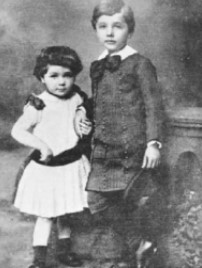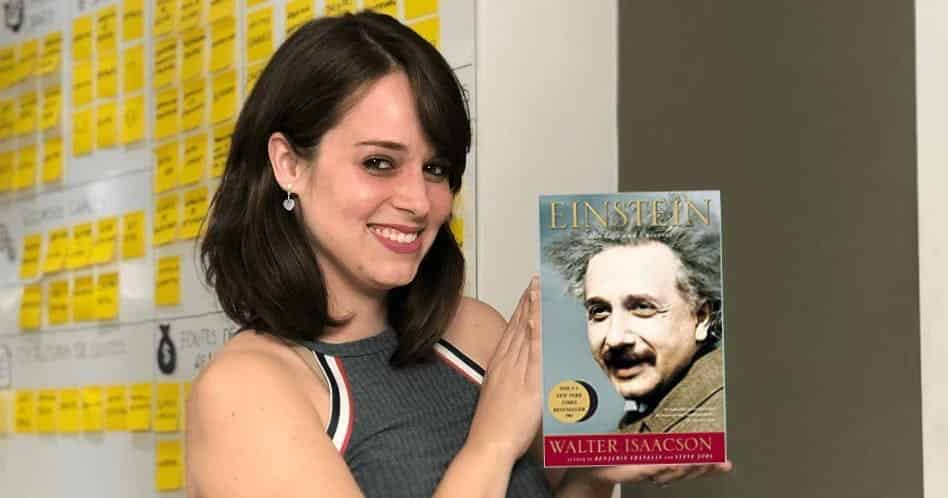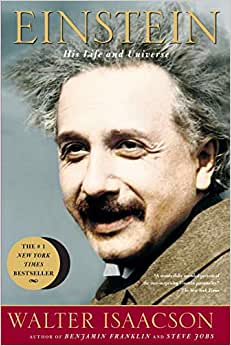
Einstein: His Life and Universe - Walter Isaacson
Unravel the universe behind the success of Albert Einstein, one of the world’s greatest geniuses and winner of the Nobel Prize in Physics, with the summary of the biography written by Walter Isaacson.
Add to Favorites
Add to read
Mark as read
Albert Einstein was one of the greatest physicists in history, and his theories, developed more than a hundred years ago, still influence – and greatly – the lives of billions of people in the 21st century.
Surely you must have seen the following equation in high school: E=mc². This equation is part of the Theory of Relativity developed by Einstein, where E = energy, m = mass and c = speed of light in a vacuum.
However, this is only one of the many legacies left by this physicist to humankind. But who was the human being Albert Einstein?
In some ways, his life was not only composed of numbers, formulas, and discoveries, but it was also filled with dramas, loves, and adventures.
And did you know that he was also a person like us? Einstein suffered from common difficulties in life, such as unemployment, unplanned children, frustrations with his studies and work.
However, you will only discover this storyline by reading the summary of the book “Einstein: His Life and Universe”. Let’s go?
The book “Einstein: His Life and Universe”
Published on May 1st, 2008, by the publisher Simon & Schuster, the book is based on a collection of letters released in 2006, twenty years after the death of the scientist's stepdaughter.
During its 675 pages, divided into 25 chapters and an epilogue, the author describes the scientist’s life exactly as the name of the book portrays it.
It shows a curious man by nature and genius, going through his childhood, studies, marriage, work as an employee in a patent office, and a physicist recognized all over the world. Thus, the work shows a new face of Einstein and portrays the intimate and little talked about life of the genius.
Who is Walter Isaacson?
Known as the biographer of geniuses, Walter Isaacson was born in the United States in 1952. For his worldwide influence, he made the Time 100 list in 2012. His academic career was shaped at Harvard and Oxford universities as a Rhodes Scholar at Pembroke College, at which he is a Honorary Fellow.
He is a former editor of the American Time magazine and former president of the CNN television network. Isaacson currently serves as CEO of the Aspen Institute, as well as being a writer and teacher.
He is the author of other bestselling books, such as “Steve Jobs”, an authorized biography written in collaboration with the magnate himself, “Leonardo Da Vinci”, and “Benjamin Franklin: An American Life”.
Why should I read “Einstein: His Life and Universe”?
While reading Albert Einstein’s biography, you will find a story of inspiration, overcoming, and most importantly, persistence! The scientist’s life was made up of trials and events that could have made him give up his career, but that’s not what happened, is it?
Therefore, if you are a fan of the physicist and are fascinated by his discoveries that influence the lives of everyone in the 21st century, you will realize that behind a Nobel Prize winner in Physics and developer of the Theory of Relativity, there was a man who also faced everyday problems.
What are the main teachings of the book “Einstein: His Life and Universe”?
- To be inspired you only need to think outside the box;
- Success is only a consequence. You must, firstly, seek to be a better person;
- Be curious! Try to understand how the simplest things around you work;
- According to Einstein, imagination is more important than knowledge;
- Many will say that you are not capable. Therefore, try to be resilient and persistent to focus on your goals;
- The will is the greatest force there is.
Who was Albert Einstein?
Our story begins in Ulm, Germany, on March 4, 1879. Born into a family of German Jews, Albert was the son of Hermann Einstein, a salesman and engineer, and Pauline Einstein.
In 1880, his family moved to the city of Munich, also in Germany. A year later, Einstein gained a sister, Maria “Maja” Einstein.

Source: Picture taken from the book “Einstein: His Life and Universe”, page 29.
When he was five years old, he became ill and had to rest for a few days in bed. In this regard, a curiosity mentioned by author Walter Isaacson is that Einstein was given a compass by his father to distract himself. It was this simple object that changed the history of humanity forever, did you know?
The enigmatic magnetic force that attracted the pointer aroused Einstein’s curiosity when he imagined that there was something hidden behind it that men could not perceive. The big difference between Albert Einstein and other people is strictly in this fact.
When we look at a compass, we see the needle moving. However, when Einstein looked at the compass, he realized that there was something moving it.
So Einstein has a famous phrase that is the explanation for his mental achievements:
“I have no special talents, I am only passionately curious.”
After this event, he began to study violin, and since then he had a great interest in the study of physics, a passion for numbers, and a dreamy spirit.
However, despite his history of genius, you surely know the story that Einstein was slow to begin speaking. In fact, it is true! Albert’s mother, Pauline, was concerned about her son’s late speech, which only occurred when he was three years old, and took him to several doctor’s appointments.
As a result, Einstein was not fully literate by the age of seven, and had problems communicating and reading, which caused him to rehearse his speech softly before he even said anything.
How was Albert Einstein’s education?
According to the author, Einstein attended an elementary school from the age of five to eight. After that, when he turned nine, he was transferred to the Luitpold Gymnasium, a renowned educational institution that emphasized math and science.
Furthermore, Walter Isaacson often refutes some beliefs, and one of them concerns Einstein’s failing mathematics when he was still a student. As the writer mentions in the book, this thought is a lie, after all, according to Einstein's sister, at the age of twelve he already showed a taste for solving applied arithmetic problems.
However, even though he was considered a spectacular student, he had difficulty in subjects that required text interpretation and languages (such as French and Greek).
At the age of sixteen, Einstein wrote his first essay on theoretical physics, called “On the investigation of the state of the ether in a magnetic field”.
Albert’s father Hermann hoped that his son would become an engineer and participate in the family business, but this craft was not attractive to him.
According to the author, Einstein had dropped out of school and did not have a high school diploma. In 1895, when he took the entrance examination at the Zurich Polytechnic for the first time, he failed the general test, which included French, zoology, botany, and politics.
However, he passed mathematics, physics, and science with ease. So Heinrich Weber, professor of physics at the Polytechnic, suggested that Albert finish his fundamental studies in Zurich, and so he did.
Which college did Albert Einstein attend?
At seventeen, Einstein entered the Zurich Polytechnic to study Physics.
However, he gradually became disenchanted with his undergraduate studies. Einstein felt that the professors focused too much on theories, which made the learning process mechanical, says Walter Isaacson. In this sense, his absence was felt by several faculty members and his reputation was fading.
The author jokes that Einstein would skip classes to study and perform experiments, and it was during this period that he met Mileva Marić, the only woman in the Department of Mathematics and Physics and his future wife.
In 1900, Albert Einstein graduated from the Polytechnic with a 4.9 grade point average, placing fourth in a class of five graduates.
What was Albert Einstein’s miracle year?
Now you might be imagining that, with his diploma, Einstein began to teach physics. However, there was one small problem: no university wanted Albert Einstein as a professor.
So, in order to get around this situation, he tried to be an assistant to some professors at the Zurich Polytechnic, but since he was a neglectful student, no faculty member accepted him. In addition, anti-Semitism was strong in Europe and contributed to the prejudice suffered by Einstein, who was Jewish.
As the author mentions, Albert Einstein got his first job at the Swiss Patent Office.

Source: Picture taken from the book “Einstein: His Life and Universe”, page 100.
In 1903, while still working in the office, Einstein and Mileva had their first child, named Hans Albert Einstein. Around this same time, he founded the Olympia Academy with two friends, where they met in Einstein's apartment to discuss science, philosophy, and politics.
Although he is not working in what he loves, Walter Isaacson recalls an event that happened to Einstein when he was still a child.
During his youth, Albert Einstein was lost in his imagination and began to imagine a person traveling next to a beam of light and how he would see the beam if the two were at the same speed.
This question was not answered until years later. In 1905, at the age of twenty-six, Albert Einstein published a series of papers on Brownian motion, the first demonstration that atoms exist.
The second article portrayed the photoelectric effect, and in the third he demonstrated that space and time are not absolute magnitudes, but relative ones, as they depend on each observer.
This is the answer to what Einstein thought as a child, as he imagined a person traveling at the speed of light next to a ray. Thus, he introduced the Special Theory of Relativity, creating the equation E=mc².
In 1908, Einstein finally got a position as assistant professor of Theoretical Physics at the University of Bern. In 1910, he and Mileva had their second child, Eduard Einstein.
Already in 1912, he returned to Zurich to teach at the Polytechnic, the university that rejected him after his graduation. During this period, Einstein was invited to join the Prussian Academy of Sciences in Berlin, but Mileva did not want to move to the city.
According to the author, one of the reasons Einstein was interested in the position was because he was in love with Elsa Einstein, his first cousin who lived in Berlin.
Einstein and Mileva moved to the city, but after a while they chose to divorce and Mileva moved to Zurich again with their two children. Albert and Elsa married in 1919.
What was Albert Einstein’s eternal legacy?
In 1915, when World War I was destroying Europe, Einstein presented the Theory of General Relativity, which showed that one of the most important concepts in physics was wrong: Isaac Newton’s classic law of universal gravitation.
For Einstein, the universe has four dimensions: height, width, depth and time. Furthermore, it is formed by a mesh called space-time that can be deformed.
The theory, elaborated by Walter Isaacson, says that the mass and density of a body cause a curvature in the mesh and that the planets of the Solar System stay in their orbits. This is not because they are attracted to the Sun, but because they are influenced by the Sun's enormous mass that warps space-time.
The theory made Einstein one of the greatest scientists of all time.
Who did Einstein’s calculations?
Walter Isaacson devoted an excerpt from Albert Einstein’s biography to clearing up a question: who helped Einstein to do the mathematical calculations?
Probably you have heard that Einstein asked some mathematicians to review his calculations. Well, his wife was a mathematician, and it is suspected that she was the helper.
During his college years, Einstein exchanged letters with Mileva Marić and referred to his studies as “our work”:
“How happy and proud I will be when the two of us together will have brought our work on the relative motion to a conclusion!”
During a trip to Serbia, the author mentions that Einstein complimented his wife with some of Mileva’s friends: “I need my wife, she solves all the mathematical problems for me”.
This being the case, she may have participated in the scientist’s first major research/studies. Besides the fact that Einstein had been divorced from Mileva for two years, but when he won the Nobel Prize in 1921, he gave half of the money to her. Was this a form of gratitude?
Which idea awarded Einstein the Nobel Prize?
In 1921, Albert Einstein was awarded the Nobel Prize in Physics. However, it was not for having developed the Theory of Relativity, because this thought was still controversial at the time and many scholars were still unable to understand it.
So the author reports that Einstein was awarded “for his services to theoretical physics and especially for the discovery of the law of the photoelectric effect”, the subject of one of his papers in 1905.
What happened to Albert Einstein’s brain?
At the age of seventy-six, Einstein was taken to the hospital due to internal bleeding caused by an aneurysm in the abdominal aorta artery. The author mentions that he did not want to undergo surgery, because he claimed that it would be in bad taste to prolong life artificially.
So, in the early hours of April 18, 1955, the world lost one of its greatest geniuses. His body was cremated in Trenton before the news spread around the world, and his ashes were scattered along the Delaware River.
However, there is a famous rumor that Einstein's brain remains preserved. Could this be true?
During the routine autopsy, pathologist Thomas Stoltz Harvey removed and analyzed each of Einstein’s major organs, and finally removed the brain and embalmed it.
Walter Isaacson further reports that Harvey asked friends at the University of Pennsylvania to slice part of the brain. Over the years, the doctor sent brain fragments to various researchers.
Compared to the brains of 25 men, Einstein’s brain had certain abnormalities, because the regions responsible for speech and language were smaller, while the ones linked to calculation were larger.
Other books to get inspired and put your plans into action
Are you a person who gets carried away by negative opinions? Einstein did not enter university after graduating. In fact, when he took the ETH Zurich exam for the first time, he did not pass, and he had not even finished high school yet.
Therefore, the book “O Poder da Ação”, “The Power of Action” in a free translation, by Paulo Vieira, will be a great ally in your professional and personal trajectory. After all, you are the only one responsible for your dreams, so react and achieve them.
What makes you want to live? Einstein was passionate about physics, and even though he worked in a field opposite to what he loved, he continued to develop theories and publish papers. The book “The One Thing” by Gary Keller will provide the necessary inputs for you to achieve maximum output and focus on success.
Finally, just like a scientist, you will need to know how to organize your study and work routine in order to reconcile these two factors. Authors Jake Knapp and John Zeratsky teach four steps for time optimization in the book “Make Time”.
How to use Einstein’s teachings in practice?
In the course of Albert Einstein’s biography, several events are shown that helped the scientist to seek even more knowledge. In this sense, we have separated some tips for you:
- Think that your knowledge is the most valuable thing about you;
- Accept failure, because it will help you achieve your goal;
- Invest in learning is investing in yourself: so focus on your personal and professional success;
- Develop persistence;
- “Non-time” is a secret used by great minds, and refers to the art of doing nothing while thinking about something.
Rate the book summary of “Einstein: His Life and Universe”
Thank you very much for checking out another summary from our platform!
Rate its quality and don’t forget to leave your feedback about the story of the great genius of science in the comments.
We also have two amazing opportunities for you: subscribe to our free newsletter and take out a premium subscription to ensure a full site experience. By listening to PocketCast for just 5 minutes, you will learn new content every day!
Purchase the complete work by clicking on the book cover below:

